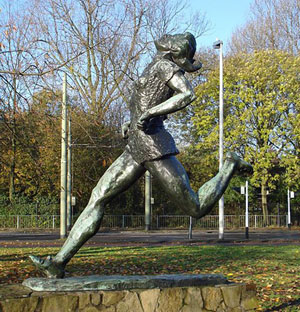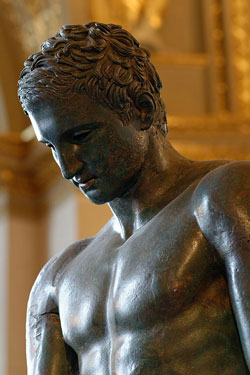
Source: Rotterdam kunstwerk . . ., Wikifrits, Wikimedia
The poem below, “To an Athlete Dying Young” by A.E. Housman, is a tribute written about a young man with athletic talent who died at an early age. Let’s look at the poem more closely and see where Housman uses some interesting poetic devices. We will be looking for metaphor, allusion, symbolism, and imagery.
To an Athlete Dying Young
The time you won your town the race
We chaired you through the market-place;
Man and boy stood cheering by,
And home we brought you shoulder-high.
Today, the road all runners come,
Shoulder-high we bring you home,
And set you at your threshold down,
Townsman of a stiller town.
Smart lad, to slip betimes away
From fields where glory does not stay,
And early though the laurel grows
It withers quicker than the rose.
Eyes the shady night has shut
Cannot see the record cut,
And silence sounds no worse than cheers
After earth has stopped the ears.
Now you will not swell the rout
Of lads that wore their honours out,
Runners whom renown outran
And the name died before the man.
So set, before its echoes fade,
The fleet foot on the sill of shade,
And hold to the low lintel up
The still-defended challenge-cup.
And round that early-laurelled head
Will flock to gaze the strengthless dead,
And find unwithered on its curls
The garland briefer than a girl’s.
 Use your notes to answer the following questions. When you are finished, check your understanding to see possible responses.
Use your notes to answer the following questions. When you are finished, check your understanding to see possible responses. 
Source: Croatian Apoxyomenos Louvre n13, Wikimedia
Metaphor
- Keeping in mind the imagery in the second stanza, what is the “stiller town” where the men are taking the athlete?
- In the fourth stanza, to what can the “shady night” be compared?
Allusion
- Why does the poet refer to “the laurel” in the third stanza?
Symbolism
- Could the athlete who died young represent anything larger?
Imagery
- What image is predominant in the first stanza of the poem?
- What image occurs in the second stanza when Housman states, “Shoulder-high we bring you home”?
Sample Responses:
Metaphor
- The “stiller town” is the cemetery where the athlete will be laid to rest.
- The “shady night” represents death.
Allusion
- In ancient Greece, laurel wreaths were awarded to victors of athletic contests.
Symbolism
- Perhaps this poem expresses sorrow for anyone who has died at a young age. On the other hand, Housman could be suggesting that to die at a young age, having accomplished much in life, is not such a bad thing. A young person, especially one viewed as champion, is likely to be remembered, but symbolically, the young athlete may represent the loss (or death) of our youth as we grow older and how quickly the accomplishments of our youth fade.
Imagery
- The reader can “see” the people cheering the boy who had won the race as the people carry him on their shoulders.
- The speaker is now talking about men carrying the athlete’s coffin on their shoulders.
The beauty of poetry is that so often it can be read on different levels. You can enjoy poetry for what it states outright, but if you dig a little deeper and ask yourself if the poet has another meaning in mind, you can often find value that might otherwise have remained hidden.